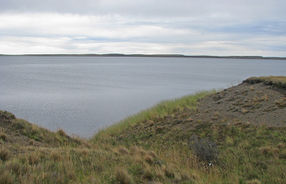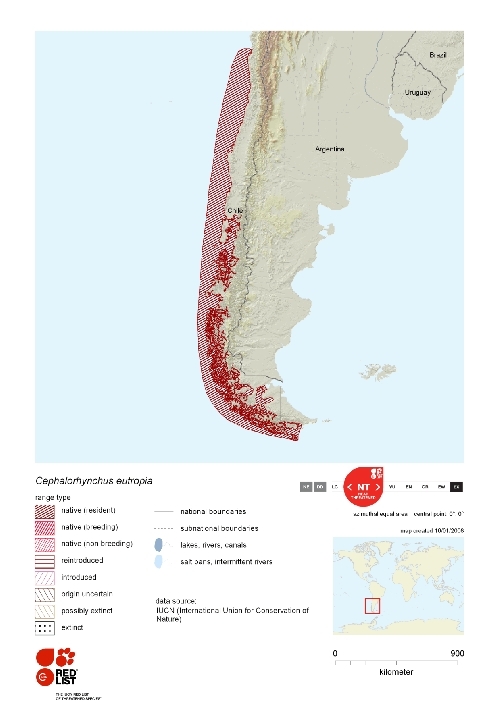Black dolphin (Biology)
Contents
Black dolphin
The Black dolphin (scientific name: Cephalorhynchus eutropia), is more commonly known as the Chilean dolphin, is only found in freshwater estruaries, and coastal areas surrounding Chile. It is a marine mammal, a member of the family Delphinidae, part of the order of cetaceans. The species is so named for its black coloring on its fins, tail, and back. It is also known as the Chilean dolphin, Piebald dolphin, Southern dolphin, and White-bellied dolphin.
Because of their preference for shallow coastal waters, these dolphins are often threatened by local fisherman. This dolphin is popularly used in Chile as crab bait, as well as a food source for humans. The species' population is decreasing because of this, and is now considered Near Threatened. Hunting restrictions have been established in Chile, however, the government has had difficulty enforcing this law in remote areas.
 Black dolphin. Source: MarineBio Black dolphin. Source: MarineBio
|
 Size comparison of black dolphin to an average adult human. Source: Chris Huh Size comparison of black dolphin to an average adult human. Source: Chris Huh
|
|
Conservation Status |
|
Scientific Classification Kingdom: Animalia (Animals) |
Physical description
Resembling fellow Cephalorhynchus species, Chilean dolphins are generally described as small and chunky with lengths of about 1.65 meters for both males and females. These dolphins weigh approximately 57 kilograms, females may be slightly larger than males (slight sexual dimorphism). Chilean dolphins have a stout, torpedo-like shape and can have a girth of up to two-thirds of their length. The head is conical in shape and lacks a beak and melon. However,black dolphinshavea large number of teeth: 24 to 31 on each side of each jaw.
The mouth line is fairly long and a groove on the sides of the face is present. The eyes are positioned just behind the mouth.
The dorsal fin is low and triangular, with a long leading edge that is almost S-shaped. The flippers are rounded and medium sized. Some animals may also have serrations occurring along the edge of the flippers. Its rounded dorsal fin, 10 to 15 centimetres, distinguishes it from the Burmeister's porpoise, which has a triangular dorsal fin with pointed tip and anterior knobs.
They are called the black dolphin because the head, pectoral and dorsal fins, tail, and the posterior of back are all black. They are dark except for three areas of white on the throat, behind the flippers, and around the anal area. The rest of the body is a complex mix of dark tones. Areas of dark gray cover the flippers, flukes, back and dorsal fin whereas lighter gray tones cover the head and sides. The blowhole may be pale gray. (Brownell and Donovan, 1988; Jefferson, Webber, and Pitman, 2007; Macdonald, 1984; Reeves et al., 2002; Ridgway and Harrison, 1994)
Chilean dolphins overlap in habitat with Commerson's dolphins (Cephalorhynchus commersonii). They can be distinguished by the lack of a conspicuous white area on the sides and back. Burmeister's porpoises (Phocoena spinipinnis) may also be confused, but they have more slender dorsal fins that are positioned farther back and a lower profile and more pointed peak. (Brownell and Donovan, 1988; Jefferson, Webber, and Pitman, 2007; Macdonald, 1984; Reeves et al., 2002; Ridgway and Harrison, 1994)
Other Physical Features: Endothermic; Homoiothermic; Bilateral symmetry
Reproduction
Chilean dolphins mate in the early winter and bear young in the spring. Females generally have one calf every two years. Sexual maturity is reached in 5 to 9 years. Other aspects of Chilean dolphin reproduction are not well understood. (Grzimek, 2004)
Female Chilean dolphins invest heavily in young through gestation and lactation. Like other dolphins, young are likely to remain with their parents for long periods during which they learn complex social behaviors, navigation, and foraging.
Key Reproductive Features: Iteroparous; Seasonal breeding; Gonochoric/gonochoristic/dioecious (sexes separate); Sexual; Viviparous
Lifespan
Although longevity has not been determined in Chilean dolphins, the related species, Cephalorhynchus commersonii and Cephalorhynchus hectori have a lifespan of up to 20 years. (Brownell and Donovan, 1988)
Behavior
This is a very shy species, found along coasts in groups of 8 to 14 individuals. There are some reports of aggregations of 20 to 50.
The black dolphin usesecholocation. There are three vocalisations that the species commonly produces: slow clicks, fast clicks and cries.
Distribution
Chilean dolphins live in the coastal waters of Chile, ranging from near Valparaiso (33°S) to south of Navarino Island (55°15'S) and as far south as Tierra del Fuego. The farthest east that this dolphin has been sighted is near the eastern mouth of the Strait of Magellan. (Brownell and Donovan, 1988; Grzimek, 2004; Reeves et al., 2002; Ridgway and Harrison, 1994)
Habitat
 Shallow coastal Magellanic Strait, southern Chile. @ C.Michael Hogan
Shallow coastal Magellanic Strait, southern Chile. @ C.Michael Hogan
On Chile's convoluted coastline, Chilean dolphins prefer to live near areas of particularly strong tidal flow above a steep dropping shelf. They are most commonly found in channels and open coasts and bays. They are also found in areas of tide rips at the mouth of fjords. They prefer cold, shallow water at depths of three to 15 meters. They may also enter rivers and estuaries and can be seen as far as five kilometers upstream. (Brownell and Donovan, 1988; Grzimek, 2004; Reeves et al., 2002; Ridgway and Harrison, 1994)
Habitat Regions: Temperate; Saltwater or marine
Food habits
Black dolphinsare able to eat solid food by six months of age.
Adults commonly feed on small schooling fish, such as sardines (Strangomera bentincki), squid (Loligo gahi, for example), and crustaceans (such as Munida subrugosa). Chilean dolphins which have been observed near salmon hatcheries may eat young, newly released salmon. (Reeves et al., 2002; Ridgway and Harrison, 1994)
Animal Foods: Fish; Mollusks; Aquatic Crustaceans
Conservation status
Chilean dolphins are listed as near threatened by the IUCN. Exact populations are difficult to measure but populations are considered in decline. Chilean dolphins have been hunted for food and as crab bait for generations. These dolphins are also accidentally caught in coastal gillnets. They also suffer from habitat encroachment by coastal salmon farming. More accurate information on Chilean dolphin populations and the threats they face is needed to formulate a conservation plan. (IUCN, 2008; Reeves et al., 2002)
IUCN Red List: Data Deficient
US Federal List: No special status
CITES: Appendix II
Threats
Accidental catchings in bait nets, and fishing are the two primary threats for this mammal. Hunting of this animal has now been deemed unlawful in Chile, however, it is difficult to enforce the law in remote areas.
This dolphin ishuntedto be used as crab and swordfishbait withinits range, andmay also be consumed by humans.
Chilean dolphins are agile and fast swimmers. Natural predation on Chilean dolphins has not been observed, but they may fall prey to Chondrichthyes and Orcinus orca. (Ridgway and Harrison, 1994)
References and Further Reading
- Encyclopedia of Life. Species curator: C.Michael Hogan. 2011. Cephalorhynchus eutropia (Gray 1846) Black Dolphin, Encyclopedia of Life
- American Cetacean Society
- IUCN, 2008. "IUCN 2008 Red List" (On-line). IUCN.(Accessed April 04, 2009)
- Marine Bio
- Brownell, R., G. Donovan. 1988. Biology of the Genus Cephalorhynchus. Reports of the International Whaling Commision, Special Issue 9: 197-279.
- Grzimek, B. 2004. Grzimek's Animal Life Encyclopedia. Detroit: Thomson-Gale.
- Hershkovitz, Philip. 1966. Catalog of Living Whales. United States National Museum Bulletin 246. viii + 259
- IUCN (2008) Cetacean update of the 2008 IUCN Red List of Threatened Species.
- Jefferson, T., M. Webber, R. Pitman. 2007. Marine Mammals of the World: A Comprehensive Guide to Their Identification. New York: Academic Press.
- Macdonald, D. 1984. The Encyclopedia of mammals. New York: Oxford University Press.
- Mead, James G., and Robert L. Brownell, Jr. / Wilson, Don E., and DeeAnn M. Reeder, eds. 2005. Order Cetacea. Mammal Species of the World: A Taxonomic and Geographic Reference, 3rd ed., vol. 1. 723-743
- Perrin, W. (2010). Cephalorhynchus eutropia Gray, 1846. In: Perrin, W.F. World Cetacea Database. Accessed through: Perrin, W.F. World Cetacea Database at http://www.marinespecies.org/cetacea/aphia.php?p=taxdetails&id=254977 on 2011-02-05
- Reeves, R., B. Stewart, P. Clapham, J. Powell. 2002. Sea Mammals of the World. London: A&C Black Publishers.
- Rice, Dale W. 1998. Marine Mammals of the World: Systematics and Distribution. Special Publications of the Society for Marine Mammals, no. 4. ix + 231
- Ridgway, S., R. Harrison. 1994. Handbook of Marine Mammals. London: Academic Press.
- UNESCO-IOC Register of Marine Organisms
- Wilson, D., D. Reeder. 1993. Mammal Species of the World; a taxonomic and geographic reference. Washington: Smithsonian Institution Press..
- Wilson, Don E., and DeeAnn M. Reeder, eds. 1993. Mammal Species of the World: A Taxonomic and Geographic Reference, 2nd ed., 3rd printing. xviii + 1207
- Wilson, Don E., and F. Russell Cole. 2000. Common Names of Mammals of the World. xiv + 204


